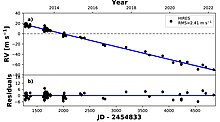Kepler-444
| Observation data Epoch J2000 Equinox 2000 | ||
|---|---|---|
| Constellation | Lyra[2]
| |
| Kepler-444 A | ||
| Right ascension | 19h 19m 00.5489s[3] | |
| Declination | +41° 38′ 04.582″[3] | |
| Apparent magnitude (V) | 8.86[4] | |
| Kepler-444 B/C | ||
| Right ascension | 19h 19m 00.3922s[5] | |
| Declination | +41° 38′ 04.013″[5] | |
| Characteristics | ||
| Spectral type | K0V[6] | |
Argument of periastron (ω)(secondary) | 227.3+6.5 −5.2° | |
| Details | ||
| A | ||
Gyr | ||
| B | ||
| Mass | 0.307+0.009 −0.008[1] M☉ | |
| Surface gravity (log g) | 5.0±0.2[2] cgs | |
| Temperature | 3,464±200[2] K | |
| C | ||
| Mass | 0.296±0.008[1] M☉ | |
| Surface gravity (log g) | ~5[2] cgs | |
| Temperature | 3,500 - 4,000[2] K | |
| Kepler-444BC: Gaia DR2 2101486923382009472[11] | ||
| Database references | ||
| SIMBAD | data | |
| B/C | ||
Kepler-444 (or KOI-3158, KIC 6278762, 2MASS J19190052+4138043, BD+41°3306)
Discovery
Preliminary results of the planetary system around Kepler-444 were first announced at the second Kepler Science Conference in 2013. At that conference, the star was known as KOI-3158.[17]
Characterization of the host star with asteroseismology was supported in part by the Nonprofit Adopt a Star program operated by White Dwarf Research Corporation, a crowd funded non-profit organization.[15]
History
On 28 January 2015, astronomers using data from NASA's
Characteristics
The star, Kepler-444, is approximately 11.2 billion years old, whereas the Sun is only 4.6 billion years old. The age is that of Kepler-444 A, an orange main sequence star of spectral type K0.[18] Despite this great age, it is in middle of its main-sequence lifespan, much like the Sun.
The original research on Kepler-444 was published in The Astrophysical Journal on 27 January 2015 under the title "An ancient extrasolar system with five sub-Earth-size planets" by a team of 40 authors.[2]
Stellar system

The Kepler-444 system consists of the planet hosting primary and a pair of M-dwarf stars. The M-dwarfs orbit each other at a distance of less than 0.3 AU while the pair orbits the primary in a highly eccentric 324-year orbit. The pair comes within 23.55 AU of the primary potentially truncating the protoplanetary disk from which the planets formed at 8 AU. This would have depleted the availability of solid material to form the observed planets.[1]
Previous stellar orbit solution was ever more extreme, period was shorter (211 years) and eccentricity was much larger (e=0.865), moving periastron to 5 AU, severely reducing the estimated protoplanetary disk size to 1–2 AU and its estimated mass from ~600 to ~4 Earth masses.[7]
Planetary system
All five rocky exoplanets (Kepler-444b; Kepler-444c; Kepler-444d; Kepler-444e; Kepler-444f) are confirmed,[16] smaller than the size of Venus (but bigger than Mercury) and each of the exoplanets completes an orbit around the host star in less than 10 days.[13][12] Thus, the planetary system is very compact, as even the furthest known planet, Kepler-444f, still orbits closer to the star than Mercury is to the Sun.[18] According to NASA, no life as we know it could exist on these hot exoplanets, due to their close orbital distances to the host star.[13] To keep the known planetary system stable, no additional giant planets can be located within 5.5 AU of the parent star.[20]
Moreover, the system is pervaded by high-order resonance chain: period ratios are 4:5, 3:4, 4:5, 4:5. This tight chain is unperturbed and very likely continues farther from Kepler-444A.
| Companion (in order from star) |
Mass | Semimajor axis (AU) |
Orbital period (days) |
Eccentricity | Inclination | Radius |
|---|---|---|---|---|---|---|
| b | — | 0.04178 | 3.600105+0.000031 −0.000037 |
0.16 | 88° | 0.406±0.013 R🜨 |
| c | — | 0.04881 | 4.545876±0.000031 | 0.31 | 88.2° | 0.521±0.017 R🜨 |
| d | 0.036+0.065 −0.020 M🜨 |
0.06 | 6.189437+0.000053 −0.000037 |
0.18 | 88.16° | 0.54±0.017 R🜨 |
| e | 0.034+0.059 −0.019 M🜨 |
0.0696 | 7.743467+0.00006 −0.0001 |
0.1 | 89.13° | 0.555+0.018 −0.016 R🜨 |
| f | — | 0.0811 | 9.740501+0.000078 −0.000026 |
0.29 | 87.96° | 0.767±0.025 R🜨 |
See also
- Kepler-80 - most compact 6-planet system discovered so far
- List of extrasolar planets
- PSR B1620-26 - an ancient planetary system in Messier 4
References
- ^ .
- ^ .
- ^ S2CID 244398875. Gaia DR3 record for this source at VizieR.
- Bibcode:2002yCat.2237....0D.</ref
- ^ S2CID 244398875. Gaia DR3 record for this source at VizieR.
- doi:10.1086/147437.
- ^ .
- ^ S2CID 198229778.
- .
- ^ a b "BD+41 3306". SIMBAD. Centre de données astronomiques de Strasbourg. Retrieved 20 August 2020.
- ^ "BD+41 3306B". SIMBAD. Centre de données astronomiques de Strasbourg. Retrieved 20 August 2020.
- ^ a b c Wall, Mike (27 January 2015). "Found! 5 Ancient Alien Planets Nearly As Old As the Universe". Space.com. Retrieved 27 January 2015.
- ^ a b c d Johnson, Michele (28 January 2015). "Astronomers Discover Ancient System with Five Small Planets". NASA. Retrieved 29 January 2015.
- AP News. Retrieved 27 January 2015.
- ^ a b Atkinson, Nancy (27 January 2015). "Oldest Planetary System Discovered, Improving the Chances for Intelligent Life Everywhere". Universe Today. Retrieved 27 January 2015.
- ^ a b c Staff (27 January 2015). "Exoplanet Catalog". Extrasolar Planets Encyclopaedia. Retrieved 27 January 2015.
- Caltech. Retrieved 28 January 2014.
- ^ a b Phil, Plait (28 January 2015). "Astronomers Find Ancient Earth-Sized Planets in Our Galactic Backyard". Slate. Retrieved 28 January 2015.
- .
- S2CID 119325005
- .
External links
- NASA – Kepler-444/KOI-3158 at The NASA Exoplanet Archive
- NASA – Kepler-444b/c/d/e/f at Extrasolar Planets Encyclopaedia

